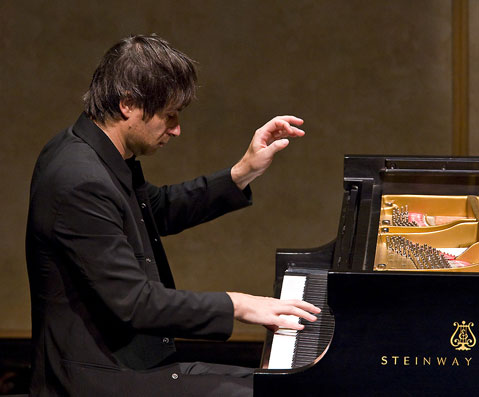Piotr Anderszewski, Piano, at the Lobero
CAMA Masterseries Begins

Piano recitals excite a special kind of anticipation. The audience includes piano teachers who sit beside prize pupils and proud parents, and everyone is dressed to impress the (usually European) virtuoso. When Piotr Anderszewski stepped into such a Norman Rockwellian scene at the Lobero last Thursday, he did so wordlessly, acknowledging the applause with a single swift nod of his impressively shaggy head. Anderszewski kept his mouth shut all night, but his playing spoke volumes.
Even before the intermission, the crowd was riveted by his performance of Bach’s Partitas Nos. 1 and 2. The sheer expressivity Anderszewski conjured out of these exceedingly difficult 20-minute solo piano exercises was astounding. Although he is better known for his interpretations of Beethoven-his recordings of the Bach Partitas are available principally on a compilation marketed as Bach for My Baby-Anderszewski delivered the most electrifying solo rendition of Bach heard in the Lobero, or anywhere else for that matter, in some time. The demands of the pieces are strenuous, particularly in regard to the coordination of left and right hands, and his were wonderfully balanced throughout.
The two selections after the interval were by Mozart and Beethoven respectively. As the program noted, the Mozart Piano Sonata No. 14 in C Minor, K. 457 was from perhaps the best year of his life, while the Beethoven Piano Sonata No. 31 in A-flat Major, Op. 110 came from 1821, one of the composer’s worst, shortly before his untimely death. The great strength of Anderszewski’s interpretive power continued to be in evidence, and he tore through the Mozart with a passion and flair for dynamics that made him sound as close as he ever will to being Beethoven’s musical twin. As with the first half’s Bach, this was not the dry academicism of the 20th century, but rather a 21st century-sounding Romantic revival of sorts.
Beethoven’s Opus 110 Sonata that followed was a model of collectedness and logic. The musical sensitivity of this famously rough and tumble late work was laid bare as Anderszewski’s elegant left hand massaged the keys in a droning magic spell. The silences that followed each movement accumulated weight and resonance until they became dramatic elements of the piece, splendidly realizing the great negative capability of the composer’s late style. At the end of this spectacular demonstration, the pianist rose from his bench, gave another wordless bow, and exited into the eternal now he had created at the keyboard.



